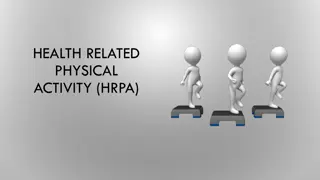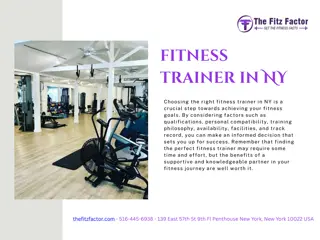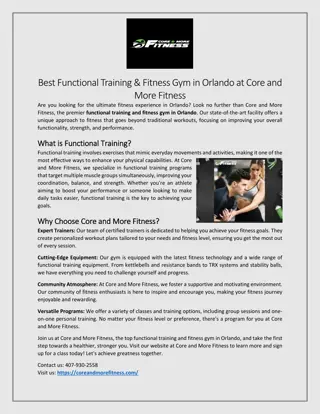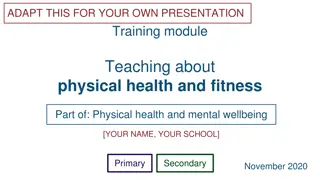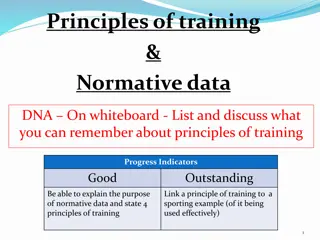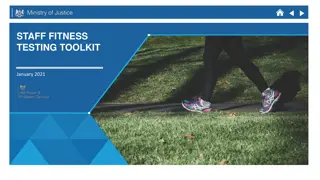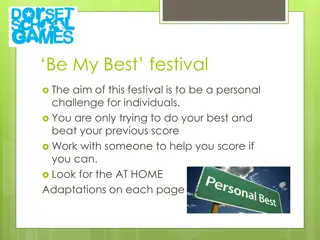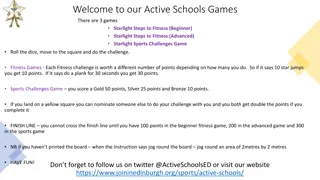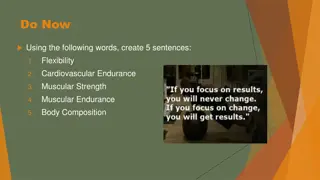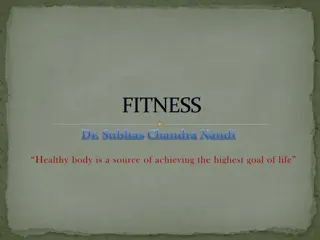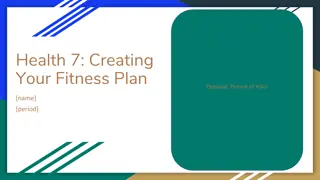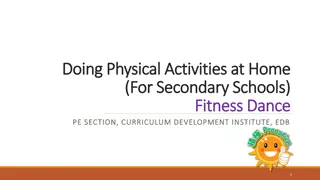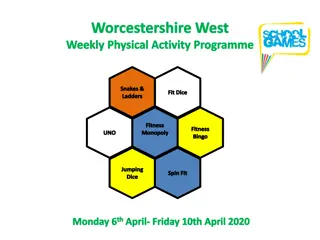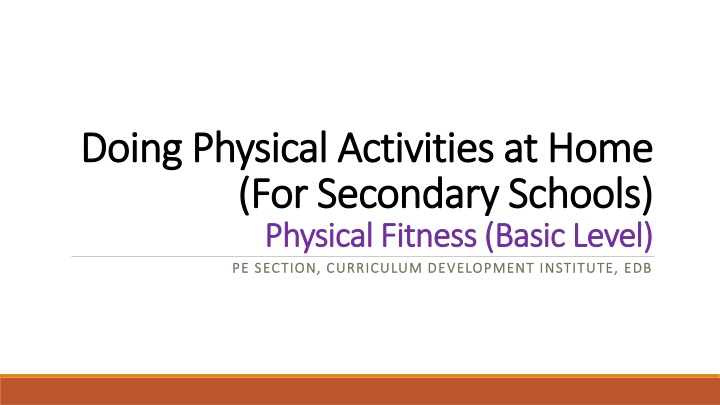
Physical Activities at Home for Secondary School Students - Fitness Curriculum
Encourage secondary school students to engage in physical activities at home for improved health and fitness, with safety measures and resources provided by the Curriculum Development Institute. Promote parent-child bonding and a healthy lifestyle through individual fitness activities.
Download Presentation

Please find below an Image/Link to download the presentation.
The content on the website is provided AS IS for your information and personal use only. It may not be sold, licensed, or shared on other websites without obtaining consent from the author. If you encounter any issues during the download, it is possible that the publisher has removed the file from their server.
You are allowed to download the files provided on this website for personal or commercial use, subject to the condition that they are used lawfully. All files are the property of their respective owners.
The content on the website is provided AS IS for your information and personal use only. It may not be sold, licensed, or shared on other websites without obtaining consent from the author.
E N D
Presentation Transcript
Doing Physical Activities at Home Doing Physical Activities at Home (For Secondary Schools) (For Secondary Schools) Physical Fitness (Basic Level) Physical Fitness (Basic Level) PE SECTION, CURRICULUM DEVELOPMENT INSTITUTE, EDB PE SECTION, CURRICULUM DEVELOPMENT INSTITUTE, EDB
Preface Preface Department of Health indicated that maintaining regular physical activity starting from childhood to adult stage will bring about tremendous health benefits and enhance physical fitness, such as increased cardiorespiratory fitness and muscular strength; reduced body fatness; lower risks of developing cancer, cardiovascular diseases and diabetes; enhanced bone health; and building resilience and reducing symptoms of depression. Besides, to maintain a healthy lifestyle could build up good body resistance. The Curriculum Development Institute of Education Bureau developed a series of learning and teaching materials for teachers reference in encouraging students to do individual physical fitness activities at home. should provide necessary support to or take part in the activities with their children. It could foster parent-child relationship and help them maintain a good health condition which leads to a healthy lifestyle. Also, parents
Safety Measures Safety Measures To wear proper clothing and footwear during activities. Exercises should be carried out individually or on a rotation basis. maintained with other people. Before activities, the floor should be ensured smooth and dry; indoor area should be kept well ventilated; adequate space and safe environment should be arranged; any glass windows, doors, table, chairs, lights, fans and sharp edges, etc. which are in close vicinity to the activity area should be installed with protective devices or be temporarily removed; all equipment must be checked for safety before use. Students should do adequate warm-up exercises at the beginning of the activity. The intensity1, duration and frequency of exercises should be arranged according to the personal health and fitness conditions. It should be started from the lowest level of difficulty. The intensity, duration and number of repetitions should be increased gradually. Natural breathing instead of holding breath should also be reminded. Pay attention to the voice volume when engaging in activities to avoid disturbing others. To drink water after the activity for replenishment. Personal hygiene should be observed. If feeling unwell during or after the activity, students should stop immediately and seek medical or professional assistance. Adequate distance should be Note1:The intensity of physical activities can be classified into low, moderate and vigorous levels: Low-intensity physical activities are simple, light and easy to do. Moderate-intensity physical activities will slightly speed up breathing and heart rate and cause mild sweating without exertion (e.g. one can still talk with ease while exercising). Vigorous-intensity physical activities will greatly speed up breathing and heart rate and cause profuse sweating and exertion (e.g. one cannot or finds it difficult to talk with ease while exercising).
Learning and Teaching Resources Learning and Teaching Resources Physical Fitness Exercise Physical Fitness Exercise (Basic level) (Basic level)
Physical Fitness Exercise Physical Fitness Exercise (Basic level) (Basic level) https://www.edb.gov.hk/tc/curriculum- development/kla/pe/Doing_Physical_Activities_at_Home/res/fitness_ex_intro.html (Chi Only) Instructions There are 30 items of physical fitness exercises in three categories, namely Physical Fitness Training without Equipment , Physical Fitness Training with Simple Equipment and Physical Fitness Training with Specific Equipment . If students do not have previous experience in circuit training or their homes do not equipped with such equipment, they should select exercises from the Physical Fitness Training without Equipment according to their ability. Each of the exercise lasts for 30 seconds, with demonstrations in three different difficulty levels ranging from easy to advanced (as shown from left-hand-side to right-hand-side). Students can choose from one for practice according to their ability and strive to complete it. In combining different exercises into a routine, different body parts should be trained alternatively. Do not repeat doing exercises for one specific body part consecutively.
Physical Fitness Exercise Physical Fitness Exercise (Basic level) (Basic level) Students should adjust the intensity, duration and number of repetitions progressively. Example: Sequence: A1-A4-A8-A2-A6-A9-A5-A10 (1 set). Do 3 sets with 10 seconds rest between each exercise and with 5 minutes rest between each set. The whole training normally takes 30 minutes.


